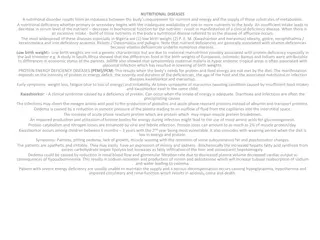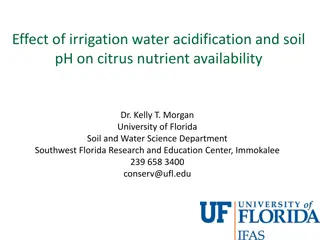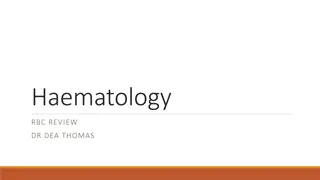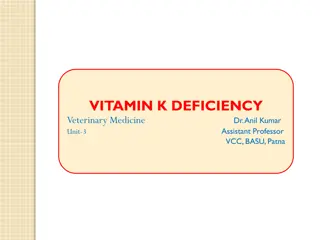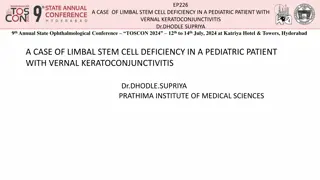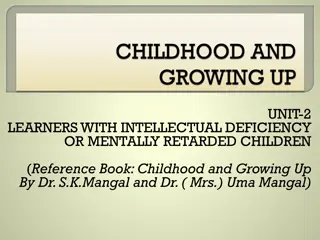Vitamin A Deficiency (Hypovitaminosis A)
Learn about the causes, symptoms, and effects of Vitamin A deficiency, including night blindness, corneal keratinization, and impaired immune function. Explore the epidemiology and pathogenesis of this condition.
0 views • 13 slides
Nutrient Uptake in Bacteria: Mechanisms and Factors
The process of nutrient uptake in bacteria, including the role of macronutrients, micronutrients, and environmental factors. Learn about the different mechanisms of nutrient transport and the importance of selective permeability in plasma membranes.
0 views • 25 slides
Efficacy and Safety of Ferric Carboxymaltose for Heart Failure with Iron Deficiency
Iron deficiency is prevalent in heart failure patients with reduced ejection fraction and is linked to poor outcomes. The HEART-FID trial investigates the impact of intravenous ferric carboxymaltose (FCM) on all-cause mortality, heart failure hospitalizations, and exercise capacity in chronic HFrEF
1 views • 17 slides
Understanding Mental Deficiency: Causes and Classifications
Mental deficiency, also known as intellectual disability, is characterized by significantly below-average intellectual functioning before the age of 18, along with limitations in adaptive behaviors. It is measured using standardized IQ tests, with classifications ranging from profound to mild. Two m
3 views • 65 slides
Grape Pomace Utilization in Soil Nutrient Management Study
Study on the mobility of total carbon, nitrogen, and polyphenols from grape pomace in soil columns, focusing on its relevance as an organic fertilizer rich in nutrients. The research also highlights the industrial potential of grape pomace, nutrient mobility between varieties, and methods used for c
1 views • 14 slides
Overview of Nutritional Diseases and Disorders
Nutritional diseases arise from imbalances between the body's nutrient and energy requirements and their supply. Nutritional deficiencies can lead to clinical diseases, while excessive intake can result in diseases of affluence. Common nutritional disorders include low birth weight, PEM, obesity, go
4 views • 6 slides
Understanding Cholestasis: Etiology, Clinical Manifestations, and Complications
Cholestasis is characterized by reduced bile flow and elevated direct bilirubin. It is critical to differentiate it from neonatal jaundice. In conditions like biliary atresia and 1-antitrypsin deficiency, early diagnosis and intervention are crucial to prevent liver failure. Clinical manifestations
5 views • 14 slides
Update on B12 Deficiency Guidance by Lothian Health Services
Vitamin B12 deficiency is a complex condition with various manifestations, including neurological symptoms. The updated guidelines address key areas such as neuro symptoms, coeliac disease, and transitioning from intramuscular to oral treatment. Testing indications and approaches for pernicious anae
0 views • 12 slides
Nutrient Recycling in Ecosystems
Nutrient recycling in ecosystems involves the continuous breakdown and exchange of elements between living and non-living components, ensuring sustainability and no long-term drain on Earth's nutrients. This process includes decomposition of organic material by bacteria and fungi, uptake of nutrient
1 views • 23 slides
Understanding Citrus Nutrient Availability in Relation to Soil pH and Irrigation Water Acidification
This research by Dr. Kelly T. Morgan from the University of Florida explores the impact of soil pH, irrigation water acidification, and nutrient recommendations on citrus trees affected by HLB disease. The study examines the availability of key nutrients such as Mn and Zn, the effects of different s
0 views • 23 slides
Enhancing Nutrient Efficiency in Agriculture for Sustainable Systems
Improved nutrient use and manure management are crucial for sustainable agricultural systems. Efforts to increase nutrient efficiency through better practices can help reduce emissions and aquatic pollution. Public awareness, policy realignment, and soil data quality enhancements are key areas for p
0 views • 14 slides
Mechanisms of Nutrient Uptake by Microbial Cells
Nutrient uptake by microbial cells involves various transport mechanisms such as passive diffusion, facilitated diffusion, active transport, and group translocation. These mechanisms ensure the specific acquisition of required nutrients by the cell through the selectively permeable plasma membrane.
3 views • 15 slides
Understanding Nutrient Pollution and Its Impact on the Environment
Nutrient pollution, characterized by the excess input of nitrogen and phosphorus into water and air, is a significant environmental issue with far-reaching consequences. It can lead to toxic algae blooms, dead zones, economic losses, and adverse effects on human health. The causes of nutrient pollut
2 views • 11 slides
Iron Deficiency Anemia in a 78-Year-Old Man: A Case Study
A 78-year-old man presents with symptoms of fatigue, headache, and abdominal pain, leading to a diagnosis of iron deficiency anemia. His medical history includes hypertension, type II diabetes, and chronic shoulder pain. Investigations reveal hypochromic, microcytic anemia with low iron levels and h
0 views • 117 slides
Understanding Post-Parturient Haemoglobinuria in Dairy Cows
Post-Parturient Haemoglobinuria (PPH) is a metabolic disease affecting high-producing dairy cows after calving, characterized by hemolysis, hemoglobinuria, and anemia. Common in buffaloes and cows, it is caused by phosphorus deficiency in diet, affecting intracellular functions and leading to clinic
0 views • 9 slides
European Standards for Plant Biostimulants Development
The European Committee for Standardization (CEN) plays a crucial role in developing European standards for plant biostimulants, focusing on improving plant nutrition processes independently of nutrient content. The CEN/TC.455 committee is responsible for creating standards supporting the EU Fertilis
2 views • 5 slides
Understanding Vitamin K Deficiency in Veterinary Medicine
Vitamin K deficiency in animals can lead to serious health issues due to its crucial role in blood clotting and bone metabolism. Different sources of vitamin K, such as plant material and bacterial fermentation, provide essential forms like K1 and K2. Factors contributing to deficiency include fat m
0 views • 8 slides
Understanding Marketing Assistance Loans (MAL) and Loan Deficiency Payments (LDP) for Farmers
Farmers can benefit from Marketing Assistance Loans (MAL) and Loan Deficiency Payments (LDP) to manage cash flow and ensure price floors for their harvested grain. MAL offers low-interest loans while LDP provides payments if prices fall below a certain level, offering financial support during challe
0 views • 39 slides
Understanding and Managing Hyperglycemic Crises: DKA and HHS
Hyperglycemic crises such as Diabetic Ketoacidosis (DKA) and Hyperglycemic Hyperosmolar State (HHS) are life-threatening emergencies characterized by severe hyperglycemia and metabolic imbalances. DKA involves absolute or near-absolute insulin deficiency leading to ketone body production and systemi
0 views • 82 slides
Rapid Elemental Analysis of Human Fingernails Using Laser-Induced Breakdown Spectroscopy
Elemental analysis of human fingernails is conducted using Laser-Induced Breakdown Spectroscopy (LIBS) to diagnose and monitor zinc deficiency in the body. Zinc deficiency is a significant health issue globally, affecting billions of people. By utilizing LIBS technology on fingernail samples, resear
0 views • 15 slides
Understanding Geochemistry and Its Impact on Human Health
This session, led by Dr. Patrick Asamoah Sakyi from the Department of Earth Science at UG, delves into the significance of geological elements in human health, discussing diseases arising from their deficiency or excess intake. Topics include geophagy, fluorine's impact on dental health, iodine defi
0 views • 48 slides
Understanding Vitamin E Deficiency in Poultry: Symptoms and Implications
Vitamin E deficiency in poultry can lead to serious conditions such as encephalomalacia (crazy chick disease) and exudative diathesis. Symptoms include ataxia, testicular degeneration, and early embryo mortality. Post-mortem lesions show soft and swollen brains with minute hemorrhages. It is crucial
0 views • 14 slides
Nutrient Criteria Development Plan for High Rock Lake Summary Update
Nutrient Criteria Development in North Carolina has evolved through various stages since 2001, with the key milestones being the development of the Nutrient Criteria Implementation Plan in 2004 and the Nutrient Criteria Development Plan in 2014. The plan aims to link nutrient concentrations with the
0 views • 8 slides
Iowa Nutrient Pollution Control Measures and Strategies
Gulf Restoration Network Decision, sources of Nutrients Nitrogen (N) and Phosphorus (P), impacts of Nutrient Pollution leading to Algae Blooms and Gulf Hypoxia (Dead Zone), measures to reduce Non-Point Source (NPS) contamination, EPA's current strategy, and Iowa's approach with its Nutrient Reductio
0 views • 20 slides
Haematology in Primary Care - Clinical Insights and Guidelines
Explore key topics in haematology such as leucopenia, B12 deficiency, and myelodysplastic syndrome with detailed guidance on interpreting full blood counts, red flags, investigations, and management strategies. Learn about special situations like B12 deficiency in pregnancy and malabsorption issues.
1 views • 30 slides
Guideline Updates on Drug Safety in G6PD Deficiency
Ongoing work includes progress on CPIC guidelines for aminoglycosides, clopidogrel, and statins, along with evidence reviews for various enzymes and medications. A review of G6PD deficiency and rasburicase safety is being conducted, categorizing drugs as low-to-no risk, high-risk, or medium-risk bas
0 views • 35 slides
Understanding Manure Management: Compositions, Nutrient Losses, and Factors
Explore the complexities of manure management by delving into manure compositions, nutrient losses, and the various factors influencing the quality and quantity of manure. Learn about the impact of animal species, diets, and management practices on manure characteristics, as well as strategies to mi
0 views • 29 slides
Understanding Nutrient Cycling in Soil for Sustainable Agriculture
Explore the intricate processes of nutrient cycling in soil, with a focus on nitrogen (N) and phosphorus (P) balances. Discover the various inputs and outputs considered within different scales, from field to country level. Gain insights into the importance of interpreting data correctly and the imp
0 views • 22 slides
Understanding Copper Deficiency in Ruminants
Copper deficiency in ruminants can be primary or secondary, affecting enzyme activity and gene expression. Risk factors include diet, soil characteristics, and breed. Pathogenesis involves effects on tissues, wool loss, body weight, diarrhea, anemia, bone health, and heart function.
0 views • 18 slides
Understanding Nitrogen Deficiency in Waterlogged Soils
Explore the impact of waterlogged soils on nitrogen deficiency in plants and discover the role of active transport, soil oxygen displacement, and chlorophyll production. Engage students in solving the issue through an interactive activity that integrates their knowledge of plant biology concepts.
0 views • 12 slides
Understanding G6PD Deficiency Hemolytic Anemia: Biochemical Basis and Implications
G6PD deficiency hemolytic anemia is an inherited condition characterized by reduced levels of glucose-6-phosphate dehydrogenase (G6PD), leading to impaired production of NADPH. This deficiency affects the Pentose Phosphate Pathway (PPP) and can result in oxidative stress, causing damage to DNA, prot
0 views • 18 slides
Understanding Paroxysmal Nocturnal Hemoglobinuria (PNH) and G6PD Deficiency Anemias
Paroxysmal Nocturnal Hemoglobinuria (PNH) is a rare acquired disorder causing hemolytic anemia due to red cell membrane defects, leading to increased sensitivity to complement. On the other hand, G6PD Deficiency is a genetic condition causing hemolytic anemia due to impaired function of the G6PD enz
0 views • 12 slides
Understanding Thiamine Deficiency and Beriberi: Causes, Symptoms, and Treatment
Thiamine (Vitamin B1) deficiency, often seen in conditions like alcoholism and poor dietary intake, can lead to serious health issues such as beriberi. This article delves into the causes, clinical features, and treatment options for thiamine deficiency, including the different types of beriberi and
0 views • 53 slides
Nutrient Watershed Permit Stakeholder Advisory Group Meeting Overview
The Nutrient Watershed Permit Stakeholder Advisory Group Meeting on December 6, 2013, discussed permit components, effluent monitoring, annual reporting, treatment optimization, nutrient studies, monitoring, reporting, support for nutrient studies, treatment plant optimization, and permit timeline.
0 views • 6 slides
Understanding Iron Deficiency Anemia and Therapy
Iron deficiency anemia occurs when the body lacks sufficient iron to produce hemoglobin, leading to symptoms like fatigue and weakness. Iron therapy, led by professionals like Dr. Haider Raheem, helps restore iron levels. Important information includes body iron distribution, absorption mechanisms,
0 views • 27 slides
Breastfeeding and Vitamin D Supplementation: Clinical Insights
Understanding the clinical presentation and risks of Vitamin D deficiency in infants, especially those who are breastfed, is crucial. This curriculum covers acute versus chronic presentations of deficiency, associated symptoms, and risk factors such as sunlight exposure, geographical location, air q
0 views • 19 slides
Nutrient Conceptual Model Review Summary
Comments and feedback on a Nutrient Conceptual Model report include suggestions to address issues related to eutrophication concepts, nutrient stoichiometry, community composition, and nutrient reduction goals. Recommendations also focus on incorporating flushing/residence time discussions, predicti
0 views • 9 slides
Anemia in Pregnancy: Types, Etiology, and Management
Dr. Methal A. Alrubaie, an assistant professor, presents a detailed overview of anemia in pregnancy. The content covers the classification of anemia types, their etiology, clinical presentation, effects on both mother and fetus, investigation methods, and treatment approaches. Various types of anemi
0 views • 19 slides
Case Study: Limbal Stem Cell Deficiency in Pediatric Patient with Vernal Keratoconjunctivitis
Limbal stem cell deficiency (LSCD) is a rare condition characterized by inadequate corneal rejuvenation and conjunctivalization of the cornea. In this case study, a 14-year-old male with Vernal Keratoconjunctivitis presented with itching, eye rubbing, and corneal epithelial scarring resembling a who
0 views • 6 slides
Understanding Learners with Intellectual Deficiency
Individuals with intellectual deficiency or mental retardation may exhibit immature behaviors, lack judgment, and show signs of delayed development. They require special care, early diagnosis, parental assistance, and educational support to reach a reasonable degree of educational achievement and so
0 views • 7 slides





